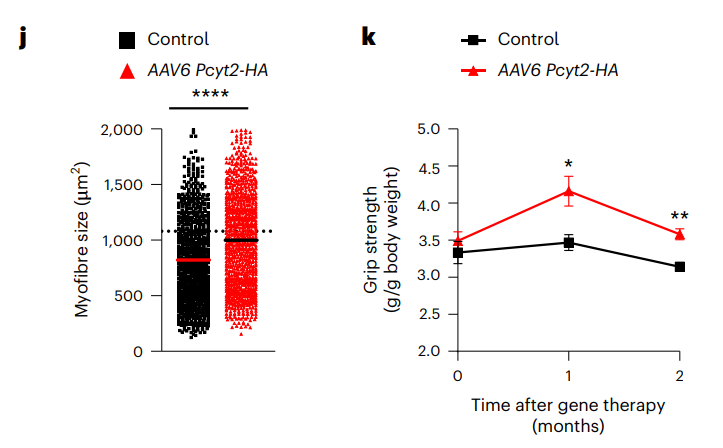Research published in Nature Metabolism has described PCYT2, an enzyme essential for muscle function, and how it declines with aging.
A necessary lipid synthesizer in muscle
Human beings need PCYT2 as part of the Kennedy pathway to synthesize two critical components of the phosopholipid membrane that surrounds cells [1]. People with genetic deficiencies of PCYT2 have stunted growth, severe motor function disorders, and muscle weakness [2], and people with similar deficiencies in the Kennedy pathway have similar symptoms [3].
The researchers recapitulated similar findings in zebrafish and mice. Without PCYT2, both of these species were considerably smaller than normal. Vital lipids, including long-chain fatty acids, were substantially depleted in the leg muscles of young PCYT2-deficient mice, which also had substantially thinner fibers. Further examination showed that the cellular membranes of their muscle cells were looser, weaker, and softer than those of normal mice.
As expected, mice with this condition did not age well. These mice frequently had spinal problems, and muscle wasting and atrophy, along with the associated low bone density, were common afflictions.
Interestingly, PCYT2 only seems to be necessary for muscle tissue. Mice that were genetically engineered specifically to lack PCYT2 in fat tissues seemed to be totally unaffected at any age.
A potentially recoverable decline with aging
In both mice and people, PCYT2 declines with age, as shown by tissue taken from ordinary, wild-type mice and human volunteers. 45- to 62-year-old people have substantially less PCYT2 than 20- to 30-year-old people. The researchers surmise that this may be a big part of the reason why resistance training becomes less beneficial with age [4].
The researchers then tested whether gene therapy could have an impact. Injecting middle-aged, pre-sarcopenia mice with an adeno-associated virus (AAV) to deliver PCYT2 to muscle tissue, they found that the affected mice had significantly higher grip strength, muscle fiber size, and muscular mitochondrial function than the control group of aged mice, although these values were not quite restored to the levels of young mice.

Conclusion
This research provides some evidence for, but does not prove, the possibility that PCYT2 deficiency with aging contributes to sarcopenia. However, as the authors state, upregulating this vital compound could be a potential treatment for muscle frailty with age. If clinical trials confirm this research, an effective gene therapy or mRNA-based treatment for frailty may be on the horizon.
Literature
[1] Gibellini, F., & Smith, T. K. (2010). The Kennedy pathway—de novo synthesis of phosphatidylethanolamine and phosphatidylcholine. IUBMB life, 62(6), 414-428.
[2] Vaz, F. M., McDermott, J. H., Alders, M., Wortmann, S. B., Kölker, S., Pras-Raves, M. L., … & Banka, S. (2019). Mutations in PCYT2 disrupt etherlipid biosynthesis and cause a complex hereditary spastic paraplegia. Brain, 142(11), 3382-3397.
[3] Ahmed, M. Y., Al-Khayat, A., Al-Murshedi, F., Al-Futaisi, A., Chioza, B. A., Pedro Fernandez-Murray, J., … & Crosby, A. H. (2017). A mutation of EPT1 (SELENOI) underlies a new disorder of Kennedy pathway phospholipid biosynthesis. Brain, 140(3), 547-554.
[4] Gault, M. L., & Willems, M. E. (2013). Aging, functional capacity and eccentric exercise training. Aging and disease, 4(6), 351.
View the article at lifespan.io








































